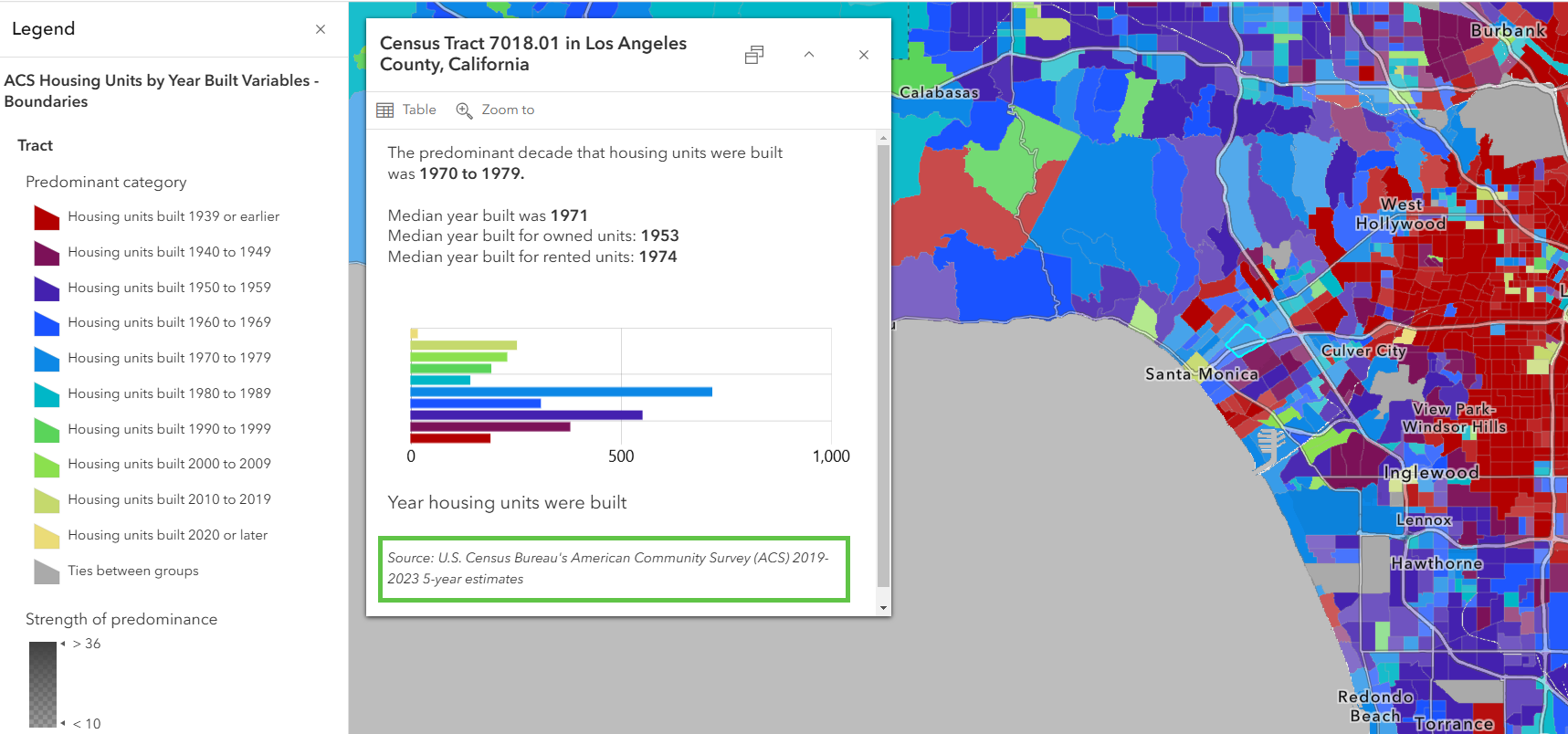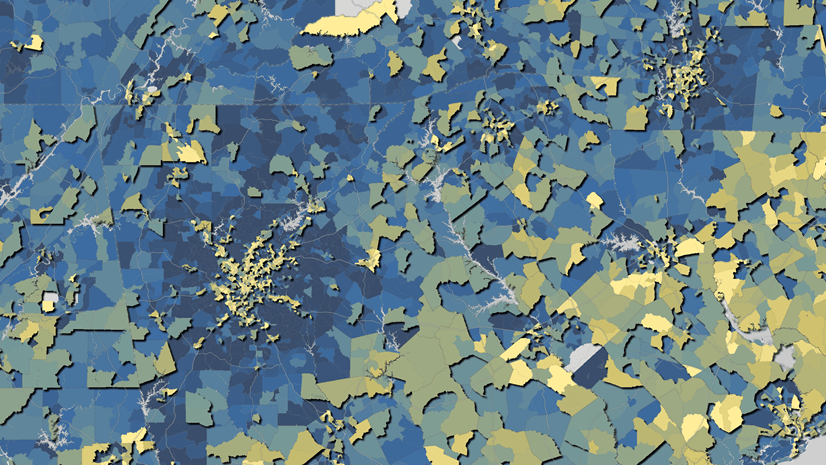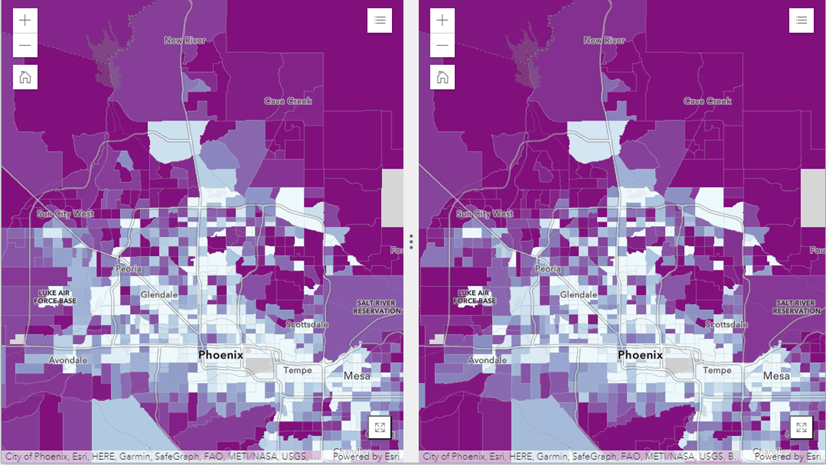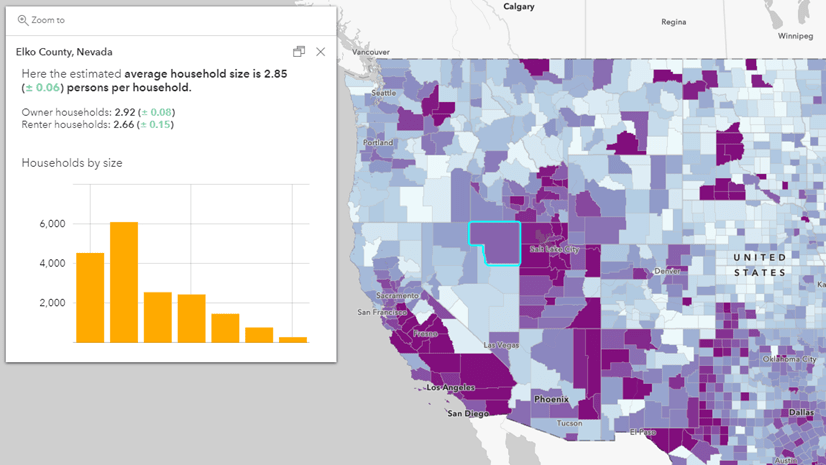The 2019-2023 American Community Survey (ACS) five-year estimates are now available within ArcGIS Living Atlas. These ready-to-use layers empower people to instantly begin to explore, map, and analyze the data. The multi-scale layers have data for state, county, and tract levels. Having free access to these layers in ArcGIS Living Atlas significantly reduces the time GIS users spend on downloading and processing data.
The Census ACS enables local officials, businesses, and researchers to understand what is taking place in their communities and helps community programs allocate resources. Access to the latest American Community Survey (ACS) data is crucial because many federal agencies are mandated to use it, and numerous non-profits rely on it for grant applications, operations, and decision-making. A wide range of users, including regional planners, program administrators, entrepreneurs, and large companies use this data to look for new locations to establish their businesses, which can lead to more local jobs.
The ArcGIS Living Atlas Policy Mapping team provides the GIS community with a collection of free layers that contain a wealth of data from the U.S. Census Bureau’s American Community Survey (ACS). On December 12th, 2024, Census released its updated five-year estimates (2019-2023). Within days, the Policy Mapping team updated the set of ACS layers already available in Living Atlas with the newest data. Any maps and apps that already use these layers automatically update to reflect the most recent Census ACS data.
Layer Enhancements
Vintage in the Pop-up

You asked, we listened!
With this release, the vintage will clearly be displayed in the pop-up. Previously, users had to go to the layers’ Item Details Page to confirm that these layers had the most recent vintage available. While this information is still there, it’s now available in the pop-up as well.

We have also included the vintage in the pop-up for the collection of 2010-2014 historical layers. These corresponding 2010-2014 boundaries layers are symbolized using the same color ramp and breakpoints as the layers containing the most recent data for a clear comparison. This helps users who are interested in showing change over time with swipe experiences in the Media Map Instant App or in ArcGIS StoryMaps.
Additional benefits of these layers:
- They are sourced directly from the U.S. Census Bureau API.
- Data undergoes rigorous QA checks at each step, comparing every value in every layer to the source.
- Source table names are documented in the Item Page, and the original Census field names are used throughout.
- The boundaries are trimmed along coastlines, lakes, and major rivers to enable cartographically pleasing maps of Census data.
- Additional attributes are already calculated for your convenience, such as percentages and their related margins of error.
- Each field is fully documented with a human-readable field alias and a long field description that explains what the field is. This information is sourced directly from Census’ technical documentation. By adding this information directly into the service, all GIS users have access to it from within ArcGIS products and can know what a field means without having to go find a metadata document.
You can use these layers today
The American Community Survey (ACS) helps local officials, community leaders, and businesses understand the changes taking place in their communities. The ACS layers in Living Atlas provide many of the popular variables directly within the ArcGIS platform. Being able to access these brand-new data values directly within Living Atlas makes it easy to start understanding the changes taking place in your community or areas of interest through maps and further analysis.
Find the layers in ArcGIS Online and ArcGIS Pro:
Learn where to find these layers and start using them within your mapping and analysis workflows. Check out this story map to learn how.
Get started:
Learn how to make a map about your community in four easy steps in this blog. You’ll have your own web map of your area in minutes.
Update your existing ACS maps:
When the new ACS figures are released by the Census and updated in Living Atlas, the Living Atlas team updates all 112 feature layers within a few days. We recommend that you check your web maps that use one of these ACS layers to see where you need to make updates to your map’s symbology and pop-ups. If you are using an ACS layer from Living Atlas and have not modified it at all, then you will appreciate knowing that your layer has already been updated, with new data, updated symbology, and updated pop-ups.
If you are using an ACS layer from Living Atlas and have modified its symbology, pop-ups, etc., you’ll find that the data has been updated, but your symbology and pop-ups kept your modifications. To confirm, check out the layer properties in Map Viewer to see what properties are stored in the source layer or stored in the web map. The attribute data in the latest five-year ACS layers changes each December and is automatically reflected in existing maps. After each release, we recommend verifying that your map’s symbology breakpoints and pop-ups show what you intend them to show with the updated data.
Understand and use Margins of Error:
We created a Learn Path full of resources that walk through different ways to incorporate margins of error (MOEs) into maps. For example, one of the steps of the Learn Path highlights this lightweight app that helps you get a quick sense of how reliable estimates are for each tract, and how they become more reliable as you aggregate tracts using the boundary of a neighborhood or other shape. Check out this blog to learn more.
Focused web maps help answer questions
In addition to the layers, you can also use pre-configured web maps that focus on specific policy questions, all available in ArcGIS Living Atlas. There are over 200 maps using ACS data in Living Atlas, and this number is ever-growing. These web maps can be used in Story Maps, Hub sites, Dashboards, Instant Apps, Experience Builder, and other configurable apps.
We put together an Atlas of the most popular maps and layers. Explore the Atlas to see examples of the types of policy topics these layers can answer. Also, explore how these maps take advantage of numerous capabilities in Map Viewer including cartographic effects, informative pop-ups, blend modes, and more.

Blog updated on 12/19/2024, and again on 1/27/2025.






Article Discussion: